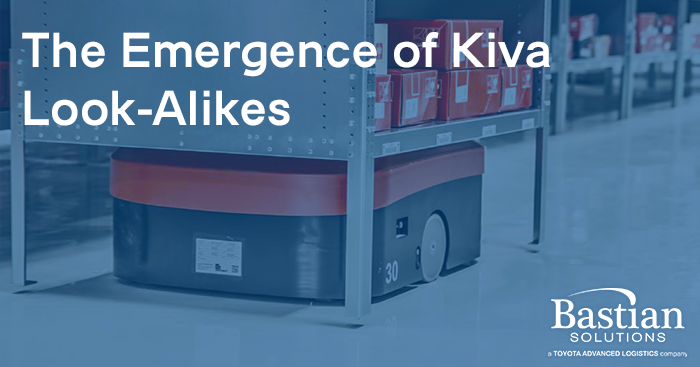
The Emergence of Kiva Look-Alikes
Wayne Lewis | 14 March 2019
For years, warehouses and distribution centers were dominated by person-to-goods order fulfillment models, where an operator walks somewhere in the warehouse, locates and retrieves an item and then sends it downstream for further processing or packs it himself. Goods-to-person (GTP) technologies, where product is brought to the operator, are becoming increasingly popular in environments where distribution requirements are more demanding, labor is costlier and scarcer and technology costs are declining. One of these goods-to-person technologies is a fetch and carry system, pioneered by Kiva Systems.
Kiva Systems turned the material handling world upside down in the early 2000s with their goods-to-person robots and dynamic shelving systems. Inspired by the challenges at Webvan, Kiva’s founder, Mick Mountz, endeavored to create a better way to pick, pack, and ship orders through a system that could deliver any item to any operator at any time. Amazon was so enamored with Kiva’s robotic solution that it acquired Kiva and their robots in March 2012 for $775 million. Since that acquisition, Amazon Robotics (as Kiva Systems was renamed) has produced over 130,000 Kiva robots and put them all to work in Amazon warehouses and DCs, thus proving the efficacy of the method.
The Amazon acquisition left a disgruntled set of Kiva customers who couldn’t expand their existing systems and a larger group of prospective clients who were left with a technological gap and no solutions. As a result, several Kiva look-alike vendors have arisen who have copied and expanded on the fetch & carry, goods-to-person fulfillment method.
What is a Fetch & Carry System?
Before examining the new Kiva-like vendors, it may be helpful to describe how a fetch and carry system works. A Kiva-like fetch and carry system utilizes autonomous vehicles (robots) to deliver mobile racks (pods) containing thousands of SKUs to workstations where operators pick and pack the items they need to fill an order.
The process starts by loading customer orders into the system’s database. Sophisticated software then orchestrates the movement of the robots, locating the closest automated guided vehicle to the items needed and directing the robot to retrieve it. As the mobile robots navigate around the warehouse in a defined grid, each robot is equipped with a sensor that prevents it from colliding with others.
Once the robot reaches the target location, it slides underneath the pod and lifts it off the ground through a lifting mechanism. Since the robots access the bins from underneath and can rotate independent of the shelving units, fewer aisles are needed. The robot then carries the pod to the specified work station to pick the items. Typically, work stations are equipped with laser pointers to direct the operator to the correct item to pick from the pod. The operator is then directed to place the item in an order location at the workstation, often by using put to light technology. Once all the items for the order have arrived, the operator packs the order and sends it downstream to shipping.
These types of systems work well when there are a large number of SKUs coupled with high throughput & service requirements. With the help of artificial intelligence, these systems automatically reslot the warehouse over time so that the fastest moving SKUs get placed closest to the workstations. Because operator travel through the warehouse is eliminated, high productivity rates can be achieved by delivering goods in a synchronized fashion to stationary operators.
One limiting factor of these systems is that they typically operate on the warehouse floor and vertical cube above the mobile racking area can be wasted. However, some of the new vendors in the market are trying to address this concern directly by using vertical reciprocating conveyors to deliver shelving units to any floor.
Overview of the Kiva Look-Alike Vendors
There are several new vendors in the marketplace trying to fill the void that Kiva left. Each of these systems contain the same fundamental components, with varying names, colors and flavors:
- Software
- Robots
- Mobile shelving units
- Operator workstations
All of these systems are expandable so that more bins and robots can be added when additional capacity is needed. The differences between the vendors primarily revolve around specifications (e.g., payloads, speeds), the pod lifting mechanism, and the software that is driving the system. Below is a brief comparison of three of the players in this space.
Is a fetch and carry fulfillment system right for your business? Perhaps. In the right applications, a fetch and carry system can help dramatically improve operational performance. We at Bastian Solutions can help you evaluate the automation, technology and material handling solutions that make the most sense for your business. Contact us to learn more.
Wayne Lewis is a Senior Manager in Bastian Solution’s Consulting group. He has over 30 years of experience in leading consulting projects and overseeing distribution operations. Wayne has worked with hundreds of companies, helping them to optimize their supply chains, re-design their fulfillment centers or plan new facilities. Industry experience includes retail, e-commerce, consumer products, food, parts distribution, healthcare as well as many other verticals.
Comments
Dave Halker says:
3/14/2019 04:57 PM
Fair and balanced. Good report!
Leave a Reply
Your email address will not be published.
Comment
Thank you for your comment.